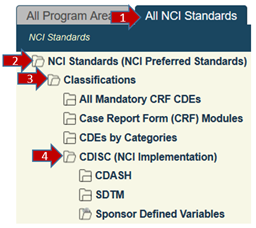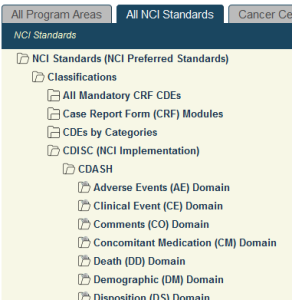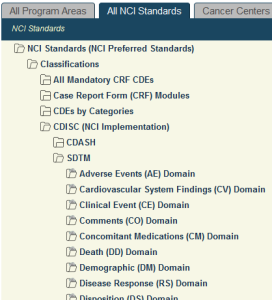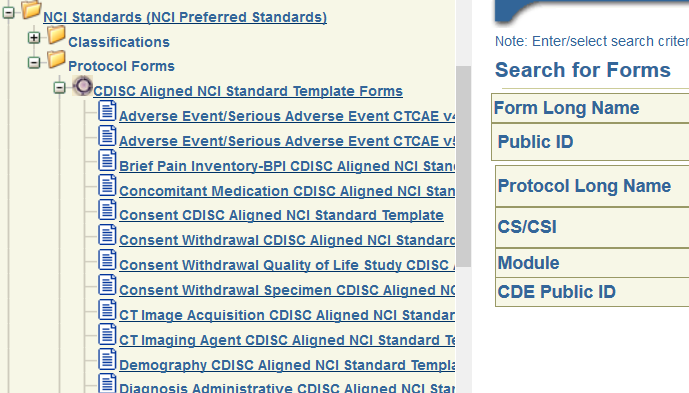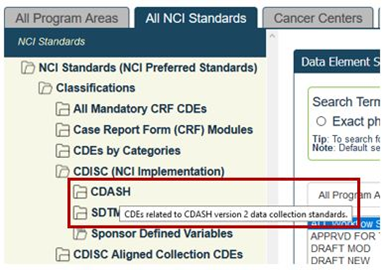Additional questions and answers will be added over time as they are received via the CADSR.RA@nih.gov email. In addition to the FAQs, an Excel template is included to assist requests for the creation of new caDSR CDEs that conform to CDISC standards and a brief presentation to guide the creation of new CDEs using the caDSR standard format.
- How do I find the CDISC CDE collection?
Open the CDE Browser and click on the following:
- All NCI Standards
- NCI Standards folder icon
- Classifications folder icon
- CDISC (NCI Implementation) folder icon
CDISC domains are located below the CDASH and SDTM folders. Click on the CDASH or SDTM folder icon to display folders for each domain. The CDEs are displayed by clicking on the domain name.
You can also search for the specific standard CRF modules using CDE Browser or FormBuilder by clicking on Protocol Forms and then the name of the standard CRF Template.
2. How can I tell what version of CDASH or SDTM is in caDSR?
If you use your mouse to hover over the CDASH or SDTM folder, you will see the latest version of content in caDSR, as shown in the picture below, “CDEs related to CDASH version 2…” When a new version of CDASH or SDTM is published, any new CDEs requests will be completed using the new version as a reference (unless otherwise requested) and the “mouse over” information will be changed.
3. I was searching for a CDE for my SDTM submission but all I can find is the CDASH CDE. Why isn’t the CDE included in the SDTM domain folder?
The CDISC CDEs are curated as requested by the caDSR user community. Our first request was for the entire CDASHIG 2.0 metadata table and so the 658 variable CDEs were created, classified by their domains, and assigned CDASH Core (Highly Recommended, Recommended/Conditional and Optional). Later requests came for SDTMIG 3.3 variable CDEs as users wanted to make sure their CDEs were compatible with both their dataset submissions and data collection applications. We recommend that searches begin with the CDASH CDEs and then SDTM if you can’t find the variable you need.
The NCI CBIIT Curation Team (also known as the Curation Team) can add CDASH variables to the SDTM domain folders by request. Send an email to caDSR.RA@nih.gov with CDISC CDE in the subject line and include the following:
CDE Public ID
New Source Classification (CDASH or SDTM)
Domain (DM, AE, EX, etc.)
4. I found a domain match for my Case Report Form (CRF) question in the CDISC models but the variable I’m looking for isn’t in caDSR. How do I request a CDE for a new CDASH or SDTM variable?
The Curation Team can create new CDEs for any model permissible, implementation guide, or therapeutic area guide variables.
Send an email to caDSR.RA@nih.gov with CDISC CDE in the subject line and include the following (or use the Template request Excel spreadsheet):
Source (CDASH or SDTM or Both)
Domain (DM, AE, EX, etc.)
Your CRF Question (CDE Preferred Question Text)
Proposed CDISC Variable label (CDE Long Name)
Proposed CDISC Variable name (CDE Short Name)
Data format (Data type and max length)
Your CRF List of values (if enumerated)
CDE Public ID for reference (if available)
5. The question on my CRF doesn’t map to any CDASH or SDTM variables but I want to collect the data in the SDTM format for dataset submission to FDA. Can I request a CDE for a non-standard variable?
Yes. A non-standard variable is any variable outside of the Standard CDASH or SDTM variables found in the model or implementation guides and are included in Supplemental Qualifier (SUPP--) datasets for each domain at the time of data submission. In addition, CDISC has an established process to create a custom SDTM domain.
Send an email to caDSR.RA@nih.gov with CDISC CDE in the subject line. Include the following information for the new CDE (or use the Template request Excel spreadsheet):
Source (leave blank)
Domain (leave blank)
Your CRF Question (CDE Preferred Question Text)
Proposed CDISC Variable label (CDE Long Name)
Proposed CDISC Variable name (CDE Short Name)
Data format (Data type and max length)
Your CRF List of values (if enumerated)
CDE Public ID for reference (if available)
6. I’m setting up a data collection form in my local system and have a question that is protocol specific. The information in the CDISC standard calls this a “sponsor defined variable.” Do I need a new CDE for this variable and how do I request curation?
Yes, a CDE is needed and the Curation Team can help. A sponsor defined variable is any variable outside of the Standard CDASH or SDTM variables found in the model or implementation guides and are included in Supplemental Qualifier (SUPP--) datasets for each domain at the time of data submission.
Send an email to caDSR.RA@nih.gov with CDISC CDE in the subject line and include the following information (or use the Template request Excel spreadsheet):
Source (leave blank)
Domain (leave blank)
Your CRF Question (CDE Preferred Question Text)
Proposed CDISC Variable label (CDE Long Name)
Proposed CDISC Variable name (CDE Short Name)
Data format (Data type and max length)
Your CRF List of values (if enumerated)
CDE Public ID for reference (if available)
7. I have a question on my CRF that I can’t map to the CDASH or SDTM model variables. Can the NCI CBIIT Curation Team help?
The Curation Team can help you verify your search for an existing CDISC CDE and/or help you with creation of a new CDE, if needed.
Send an email to caDSR.RA@nih.gov with CDISC CDE in the subject line and include the following information (or use the Template request Excel spreadsheet):
Your CRF question text, pick list values (if any) or data format (data type and maximum character length)
CDISC Observation Class and Domain that matches your expected data
8. I need to create a custom variable. How do I request a CDE?
While the term “custom variable” isn’t found in the CDISC CDASH or SDTM documentation, it’s often used to mean the same thing as a non-standard, supplemental qualifier, or sponsor-defined variable. At the time of submission, the data are included in Supplemental Qualifier (SUPP--) datasets for each applicable domain.
Send an email to caDSR.RA@nih.gov with CDISC CDE in the subject line and include the following (or use the Template request Excel spreadsheet):
Source (leave blank)
Domain (leave blank)
Your CRF Question (CDE Preferred Question Text)
Proposed CDISC Variable label (CDE Long Name)
Proposed CDISC Variable name (CDE Short Name)
Data format (Data type and max length)
Your CRF List of values (if enumerated)
CDE Public ID for reference (if available)
9. I have an Eligibility Criteria checklist that has inclusion and exclusion questions. There’s an example dataset for the Trial Domain (TI) for Inclusion/Exclusion criteria in SDTM but it doesn’t capture any of the Yes/No data I’ll be collecting for the questions on my form. What do I do to make these CDISC compatible?
Since FDA doesn’t mandate the format for collection of data, you can always use the same CDEs you’ve used in the past for these questions. At the time of data submission, the data will need to be transformed into the SDTM format.
If you prefer, the Curation Team can curate new CDEs to match the SDTM formatted dataset. Send an email to caDSR.RA@nih.gov with CDISC CDE in the subject line. You will need to provide the following information (or use the Template request Excel spreadsheet):
Source (CDASH)
Domain (IE)
Your CRF Question (CDE Preferred Question Text)
Proposed CDISC Variable label (CDE Long Name)
Proposed CDISC Variable name (CDE Short Name)
Data format (Data type and max length)
Your CRF List of values (if enumerated)
CDE Public ID for reference (if available)
10. I want to be sure to use CDISC Standard CDEs for my data collection CRF but when I compare my form to the SDTM example dataset for submission, the formats are really different. I can see that SDTM uses a vertical approach or “normalized” to submission dataset format but I collect the data in a “flattened” or horizontal format in my eDC system. How can I find the best CDEs to use?
If you’re unable to modify your CRF to use the vertical structure of the SDTM dataset example, the best thing to do is to search for CDASH CDEs to match your CRF questions. If you can’t find a CDASH CDE, search for SDTM CDEs next. Sometimes the best solution may be to collect the data as you always have using your CRF and then transform and format the data at the time of submission using the SDTM example.
11. My CRF contains information that would be considered Personally Identifiable (PII) or Protected Health Information (PHI). Do I need to make the CDEs I’m using in my Electronic Data Capture (EDC) system CDISC compatible?
No. There are no CDISC standards, whether in CDASH or SDTM, for PII or PHI data. You can collect that data using the same CDEs you’ve always used or find applicable CDE standards to use in your EDC since you won’t be submitting that data to the FDA.
12. I’m using a Patient Reported Outcomes (PRO) quality of life questionnaire in my protocol. How can I make sure the CDEs I’m using are CDISC compliant/compatible?
You can still continue to use the same CDEs you always have to collect your PRO questionnaire data since there are no FDA guidelines about the collection of data. However, CDISC develops SDTM QRS supplements that provide information on how to structure the data in a standard format for public domain and copyright-approved instruments for FDA data submission. The NCI CBIIT Curation Team is currently mapping the existing CDEs to these questionnaires and developing new CDEs where needed.
If I want to use CDISC compliant CDEs, how do I request them?
Send an email to caDSR.RA@nih.gov with CDISC CDE in the subject line and include the following information:
Questionnaire Name
Source with information concerning the applicable copyright or licensing restrictions
We will follow up with your request and let you know what CDEs exist or can be created.
13. I mapped my demographics questions to CDISC variables. I found some CDEs that match, but some that don’t. Can CBIIT verify my CDISC mappings are correct and if they can, suggest CDISC compatible CDEs?
The Curation Team can only verify that you have chosen the correct CDEs from the CDISC collection. We can’t perform mappings or confirm that you’ve chosen the correct variables for your CRF questions and responses.
14. Will CBIIT automatically create new CDISC compatible CDEs for the questions I couldn’t find in caDSR?
The Curation Team will not automatically create new CDEs. Once you’ve chosen the variables that map to your questions/responses and searched the existing content in caDSR, you can request to have the missing CDEs curated by the NCI CBIIT Curation Team or trained caDSR Curators can create their own CDEs following the guidance provided in the CDE Curation Basics for CDISC presentation.
Send an email to caDSR.RA@nih.gov with CDISC CDE in the subject line. You will need to provide the following information (or use the Template request Excel spreadsheet):
Source (CDASH or SDTM or Both)
Domain (DM)
Your CRF Question (CDE Preferred Question Text)
Proposed CDISC Variable label (CDE Long Name)
Proposed CDISC Variable name (CDE Short Name)
Data format (Data type and max length)
Your CRF List of values (if enumerated)
CDE Public ID for reference (if available)
15. I have values in my list that don’t already exist in the CDISC Controlled Terminology (CT) value set when I looked in the EVS Term Browser.
a. How do I request additions to the CT value set?
The NCI CBIIT Curation Team can help you with requesting new values for an existing or new CDISC CDE for the CDISC CTs.
Send an email to caDSR.RA@nih.gov with CDISC CDE in the subject line and include the following information:
Your CRF Question
Proposed response value(s)
Proposed Response value definition(s)
b. How will new values be added to the CDISC compatible CDEs?
The Curation Team monitors EVS and is notified of the CDISC CT Package quarterly releases in the NCI Thesaurus. At that time, we check all existing CDE Value Domains and update the list of permissible values accordingly. Information is included in all CDISC CDEs associated with CT value sets to let you know the latest package that’s been applied.
16. I requested a new value for the CDISC coded terminology list but EVS/CDISC did not approve. How do I add it to my form? How do I submit the data to FDA?
If your requested value is not approved by EVS or CDISC for addition to the CT value set, you should receive information from CDISC about why it was rejected along with an alternative solution(s). You can still collect and submit that data. The NCI CBIIT Curation Team or trained caDSR Curators can add values to a new or existing CDE (owned by your Context) for use with your eDC system.
Send an email to caDSR.RA@nih.gov with CDISC CDE in the subject line and include the following information:
CDE Public ID (for reuse, if existing)
Your CRF Question
Proposed response value(s)
Response value definition(s)
At the time of data submission, your study team can use sponsor defined terminology for the SDTM formatted dataset.

